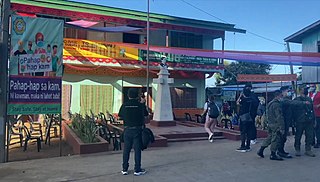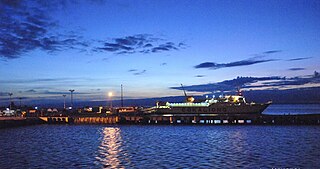
Zamboanga Peninsula is an administrative region in the Philippines, designated as Region IX. It consists of three provinces including four cities, and the highly urbanized Zamboanga City. The region was previously known as Western Mindanao before the enactment of Executive Order No. 36 on September 19, 2001. The city of Zamboanga was designated as the regional center until Pagadian was designated as its new regional center, although Zamboanga City remains the region's cultural, economic, and educational center.

Isabela, officially the City of Isabela, is a 4th class component city and de facto capital of the province of Basilan, Philippines. According to the 2020 census, it has a population of 130,379 people.

Dipolog, officially the City of Dipolog, is a 3rd class component city and capital of the province of Zamboanga del Norte, Philippines. According to the 2020 census, it has a population of 138,141 people.

Pagadian, officially the City of Pagadian, is a 2nd class component city and the capital of the province of Zamboanga del Sur, Philippines. It is the regional center of Zamboanga Peninsula and the second-largest city in the region, after the independent city of Zamboanga. According to the 2020 census, it has a population of 210,452 people. The city will be converted to a highly-urbanized city by the virtue of Proclamation No. 1247, signed by President Rodrigo Duterte dated November 08, 2021, but shall take effect after the ratification in a plebiscite.

New Washington, officially the Municipality of New Washington, is a 3rd class municipality in the province of Aklan, Philippines. According to the 2020 census, it has a population of 47,955 people.

Mapun, officially the Municipality of Mapun, is a 4th class municipality in the province of Tawi-Tawi, Philippines. According to the 2020 census, it has a population of 30,038 people.

Sitangkai, officially the Municipality of Sitangkai, is a 1st class municipality in the province of Tawi-Tawi, Philippines. According to the 2020 census, it has a population of 37,319 people.

Buug, officially the Municipality of Buug, is a 3rd class municipality in the province of Zamboanga Sibugay, Philippines. According to the 2020 census, it has a population of 38,425 people.

Ipil, officially the Municipality of Ipil, is a 1st class municipality and capital of the province of Zamboanga Sibugay, Philippines. According to the 2020 census, it has a population of 89,401 people. It is the most populous municipality of Zamboanga Sibugay.

Liloy, officially the Municipality of Liloy, is a 3rd class municipality in the province of Zamboanga del Norte, Philippines. According to the 2020 census, it has a population of 42,213 people.

Sindangan, officially the Municipality of Sindangan, is a municipality in the province of Zamboanga del Norte, Philippines. According to the 2020 census, it has a population of 103,952 people.

Ozamiz, officially the City of Ozamiz, is a 3rd class component city in the province of Misamis Occidental, Philippines. According to the 2020 census, it has a population of 140,334 people.

Bayog, officially the Municipality of Bayog, is a 3rd class municipality in the province of Zamboanga del Sur, Philippines. According to the 2020 census, it has a population of 34,519 people.

Molave, officially known as the Municipality of Molave, is a 1st class municipality in the province of Zamboanga del Sur, Philippines. In the 2020 census, it had 53,140 people. It is in the eastern part of the province of Zamboanga del Sur, and has an area of 21,685 hectares. The name "Molave" refers to the tree that was common in the area. Its economy is focused on agricultural production, and 1,378.5 hectares of fertile land is irrigated and planted with rice. Corn, coconut, cassava, banana, camote and various vegetables are also grown. These are marketed to neighboring towns and cities, and reach Cebu. Due to its strategic location, Molave is becoming the commercial hub of the Salug Valley.

Tukuran, officially the Municipality of Tukuran, is a 4th class municipality in the province of Zamboanga del Sur, Philippines. According to the 2020 census, it has a population of 42,429 people.

Vincenzo A. Sagun, officially the Municipality of Vincenzo A. Sagun, is a 5th class municipality in the province of Zamboanga del Sur, Philippines. According to the 2020 census, it has a population of 24,852 people.
The legislative districts of Zamboanga City are the representations of the highly urbanized city of Zamboanga in the various national legislatures of the Philippines. The city is currently represented in the lower house of the Congress of the Philippines through its first and second congressional districts.
Putik is one of the developing barangays in Zamboanga City. Situated at six kilometers east of the city proper. The name "putik" is ironic to the bustling economic situation of the barangay. It has one of the most number of subdivisions and a number of public and private offices. It serves as a residential, commercial and agricultural area.

Zamboanga City, officially the City of Zamboanga, is a 1st class highly urbanized city in the Zamboanga Peninsula region of the Philippines. According to the 2020 census, it has a population of 977,234 people. It is the fifth-most populous and third-largest city by land area in the Philippines. It is the commercial and industrial center of the Zamboanga Peninsula Region.

Lamao is the 17th barangay of the municipality of Liloy, Zamboanga del Norte, respectively. The Barangay Captain is Hon. Pio Absin Jr. It has a land area of 220.21 (ha.), the Hall of the Barangay has a covered court(front) and a kindergarten school(behind). There are two routes, the 1st is Liloy - Lamao Port, 2nd is the Moalboal-Warningan, the 2 common puroks also found namely, the Purok of Magsaysay lies north to the coast, which the Barangay Hall is located. Next, the Purok of Mabuhay also lies near the port. The official Port of the Municipality is located in this said Barangay. The population is estimated of 1,000 above. The Main Religion of the Barangay is Christianity, its patron is Senior San Roque and the patroness is Saint Felomina, the chapel is located behind the Hall. Most people living in the Barangay are Christians. Their main staple diet is rice and the so-called saging which named in English as Cooked Banana. Of course, basketball is the most featured game. This Barangay has well-known and nice beaches, which are the Bitoon Beach and the Babami Beach Resort.


















